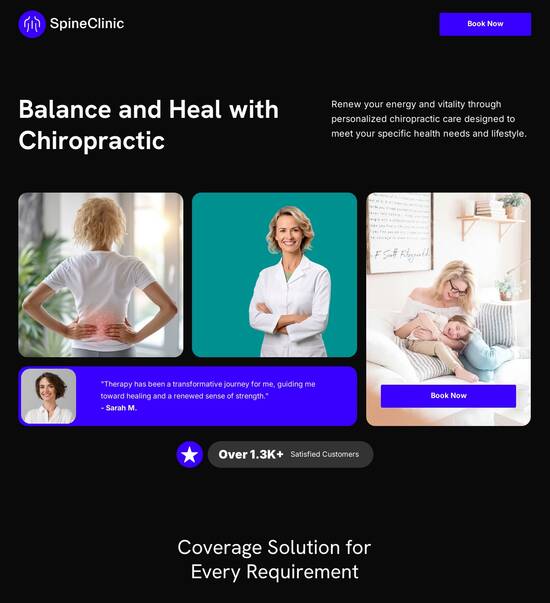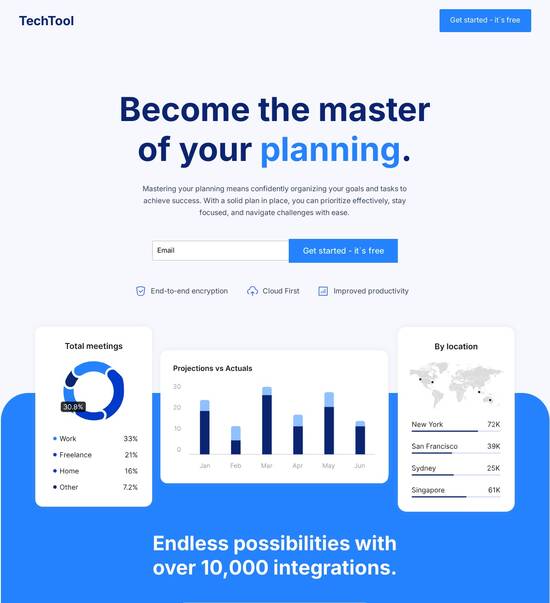
Modern glossary page template
Explore Similar TemplatesAbout template
Unleash your creativity with the modern glossary page template. Try Instapage today.
Recommended templates

Easy to build without coding
With the intuitive drag-and-drop builder, anyone on your team can create high-converting pages without any knowledge of code or design. Make enhancements to your landing page with custom widgets using Javascript, HTML/CSS, or third-party scripts.

Multiple layouts for any industry and goal
Select from 500+ landing page layouts built to boost conversions across industry-specific scenarios. Customize them by adjusting fonts, adding images, and generating on-brand content with the AI assistant. Quickly scale with Instablocks® and Global Blocks that you can save, reuse, and update globally.

Loads fast and looks polished on any device
Every template is responsive, which means they present professionally on any device and load blazingly fast with our Thor Render Engine. You can also power them up with Google AMP technology to deliver an unparalleled mobile experience and drive higher conversions.

Robust analytics & experimentation
Get real-time updates and reporting across all your devices, showing the number of visitors, conversions, cost-per-visitor, and cost-per-lead. Launch AI-powered experiments, run A/B tests, and use heatmaps to analyze user behavior, then optimize your landing page to maximize conversions.







Easy to build without coding
With the intuitive drag-and-drop builder, anyone on your team can create high-converting pages without any knowledge of code or design. Make enhancements to your landing page with custom widgets using Javascript, HTML/CSS, or third-party scripts.
Multiple layouts for any industry and goal
Select from 500+ landing page layouts built to boost conversions across industry-specific scenarios. Customize them by adjusting fonts, adding images, and generating on-brand content with the AI assistant. Quickly scale with Instablocks® and Global Blocks that you can save, reuse, and update globally.
Loads fast and looks polished on any device
Every template is responsive, which means they present professionally on any device and load blazingly fast with our Thor Render Engine.
Robust analytics & experimentation
Get real-time updates and reporting across all your devices, showing the number of visitors, conversions, cost-per-visitor, and cost-per-lead. Launch AI-powered experiments, run A/B tests, and use heatmaps to analyze user behavior, then optimize your landing page to maximize conversions.
All the features you need to build lead-generating landing pages
Explore more featuresLearn how to build top-performing landing pages for any goal
FAQs
Leading the way in building high-performing landing pages





A step-by-step guide to maximizing your marketing campaigns with Instapage
Effective landing pages are the backbone of successful digital marketing campaigns. With Instapage's all-in-one landing page and conversion rate optimization (CRO) platform, marketers can easily accelerate, optimize, and scale their efforts. Let's dive into how you can leverage Instapage to create impactful landing pages that drive results.
Understanding the importance of landing pages
Landing pages are tailored web pages designed to boost conversions. They serve as a focal point for your marketing strategies, offering potential customers a dedicated space to engage with your offerings. By utilizing Instapage's templates and lead generation elements, you can enhance user experience and optimize your page for maximum ROI. Key features include access to over 100 high-converting templates and user-friendly design tools, making page creation straightforward and efficient.
- High-performance templates: Choose from a diverse range of pre-designed templates specifically aimed at different industries.
- Lead generation tools: Utilize intuitive elements like forms, call-to-action buttons, and chat options to capture leads effectively.
- Mobile optimization: Ensure that all landing pages are responsive and perform well across various devices.
Setting up your landing page with Instapage
Creating a landing page on Instapage is a simple yet effective process. Follow these steps:
- Select a template: Choose a template that matches your marketing goals and customize it to reflect your brand.
- Leverage Instablocks: Use flexible layout options and pre-made sections to ease the design and build process without code.
- Implement forms: Add lead capture forms strategically placed to encourage visitor interaction and conversion.
Optimizing and personalizing your landing page
Once your page is active, the next step is to focus on optimization and personalization.
- A/B testing: Use built-in experimentation features to compare different versions of your landing page and determine which performs best.
- Heatmaps: Analyze user behavior with Instapage’s heatmaps to identify areas for improvement.
- Dynamic content: Tailor audience experiences using dynamic text replacement and other personalization strategies to increase relevancy.
With these strategies, your landing pages will not only attract clicks but also convert them into valuable leads.
In conclusion, leveraging Instapage equips marketers with the tools necessary to transform their digital marketing campaigns effectively.
Ready to elevate your marketing strategies? Start using Instapage today and unlock the full potential of your campaigns!
People also ask about Modern glossary page template
Unveiling the Modern Glossary Page Template: A Comprehensive Exploration
Defining the modern glossary page template
A glossary page template serves as a structured framework that organizes definitions and terms relevant to specific content areas. It is designed to assist users in navigating specialized jargon that may be encountered in long-form documents or websites. By defining technical or niche terms, glossary pages significantly enhance user experience and understanding.
The significance of a modern glossary page becomes apparent in content-rich environments such as educational websites, corporate documentation, and digital marketing strategies. These templates facilitate easier comprehension, allowing users to engage more deeply with the material. As information continues to expand, glossary pages have become essential tools for clear communication.
Evolution of glossary pages
Historically, glossaries took the form of static pages with limited interactivity. As websites have transitioned into richer, more dynamic content formats, glossary pages have evolved to provide greater functionality. The incorporation of search features, for example, has allowed users to quickly find definitions without scrolling through extensive lists.
The rapid advancement of digital tools has played a crucial role in this evolution. As tools for content creation and management have improved, so too have the ways in which glossary terms can be displayed and updated. This shift is greatly influenced by the growing importance of user experience and ongoing digital transformation in various industries.
Key components of a modern glossary page template
Structuring the layout of a glossary page is vital. Essential sections should feature clear headings for categories, terms, their meanings, and even examples, if appropriate. A well-organized glossary supports intuitive navigation, allowing users to seamlessly find the information they need while avoiding frustration.
Headings that categorize terms by subject matter.
Alphabetical listings of terms for easy reference.
Concise definitions that clarify the meaning of each term.
Integrating glossary terms and their definitions is equally crucial. Definitions should be crafted to be clear and straightforward, avoiding overly complicated language that could alienate less knowledgeable users. Leveraging concise language helps users quickly understand terms and promotes engagement.
Utilizing glossary table templates
One effective strategy in designing a modern glossary page is to employ tables for organization. Tables allow for a more structured presentation of terms and definitions, enhancing visual appeal and user engagement. A clear visual hierarchy guides users through the content, making important information stand out.
Tables make scanning for terms quicker and easier.
Visual representation aids in memory retention for users.
Implementing tables not only boosts organization but also contributes to a cleaner design that appeals to modern users seeking efficient information retrieval.
Tailoring file formats for flexibility and accessibility
When considering glossary template file formats, it's crucial to choose ones that align with user needs. Common formats such as HTML, Markdown, and Word documents each present unique advantages and challenges. HTML is ideal for web integration, providing interactive capabilities, while Markdown offers simplicity and speed.
HTML allows for easy integration with websites but can be complex for editing.
Markdown is user-friendly and straightforward but lacks format styling.
Word documents are great for offline use but not optimal for web display.
Selecting the right format can lead to smoother content updates and easy maintenance, ensuring your glossary is always up-to-date and accessible regardless of the platform.
Enhancing user experience with advanced features
To provide an exceptional user experience, incorporating interactive elements into glossary pages is essential. Features such as built-in search functionality enable users to quickly find specific terms, enhancing engagement and usability. By allowing users to type in their queries, a one-click solution to definitions can significantly save time.
Additional advanced features worth considering include hyperlinks to related terms. This makes it possible for users to explore concepts further, driving deeper engagement with the content. Personalization options, where users can adjust the glossary view, also add value and cater to individual preferences.
Crafting effective end-user documentation with glossaries
Glossaries play a critical role in software documentation, especially for clarifying jargon and terminology that may confuse the average user. By offering clear definitions alongside technical terms, glossaries improve comprehension and empower users to make the most of the provided software tools.
Including glossaries in user manuals helps streamline the onboarding process.
Employing glossaries in FAQs can alleviate recurring questions.
Best practices recommend placing glossaries prominently within documentation so they can be easily accessed. Keeping content updated and accurate is essential to ensure users can trust the information they are reading.
The broader impact of glossary pages on content domains
Glossaries serve diverse audiences by providing clarity in complex fields. They are particularly beneficial for those less familiar with specialized jargon, establishing a pathway for deeper understanding. This is especially true in industries like technology, healthcare, and finance, where terminology can be intricate and varied.
Glossaries can demystify concepts, fostering inclusivity.
They are invaluable in improving communication between experts and novices.
Additionally, glossary pages can positively impact SEO strategies. By creating content centered around relevant glossary terms, businesses can enhance keyword relevance, which in turn boosts search rankings. This strategic use of glossaries can lead to increased organic traffic and visibility.
Technical considerations for developing glossary templates
When developing a glossary template, identifying the right software tools is critical. Various platforms can facilitate seamless creation and maintenance of glossary pages, including content management systems and collaborative tools. Ensuring compatibility with existing systems is equally important, as it aids in smooth integration.
Utilizing popular CMS platforms allows for easy implementation of glossary pages.
Collaboration tools can enhance teamwork during the glossary development process.
Furthermore, coding and customization options should not be overlooked. Simple HTML/CSS edits allow users to personalize templates to better suit brand aesthetics. Moreover, leveraging available plugins and add-ons can provide enhanced features that improve overall functionality.
Case studies: Successful implementation of glossary page templates
Examining real-world examples illustrates the tangible benefits of effective glossary page implementation. Industries such as technology and education have successfully integrated glossary pages that enhance comprehension and elevate user experience. For instance, a tech company created an interactive glossary that allowed users to delve into related terms, ultimately leading to greater product understanding.
Educational institutions use glossaries to aid students navigating complex subjects.
Marketing agencies leverage glossaries to clarify industry terminology for clients.
User testimonials often highlight the impact of these glossaries, emphasizing how easy it was to grasp complicated concepts. Monitoring key performance indicators can further validate success stories, underscoring improvements in user engagement and satisfaction.
Future trends in glossary features and functionalities
Emerging technologies like AI and machine learning are poised to transform the landscape of glossary pages. Adaptive glossaries that evolve based on user engagement and preferences could soon become the norm, ensuring definitions remain relevant. Additionally, voice-activated glossary searching can significantly ease access to information.
AI-enhanced glossaries could provide personalized term suggestions.
Voice search may facilitate quicker access to definitions in hands-free situations.
These trends indicate an ongoing evolution of glossary functionalities, reinforcing their importance in a continuously digital world. As users' needs shift, glossary designs will need to adapt accordingly to remain effective.
Concluding thoughts on the role of modern glossary page templates
Glossaries are not just supplementary resources; they are vital components for knowledge sharing. By enhancing understanding through accessible language and information, glossaries promote collaboration across diverse domains, fostering inclusivity and clarity.
As content continues to evolve, so too must glossary development. The commitment to continuous improvement and innovation will ensure that glossary pages remain relevant tools for education and user engagement. It is essential for teams to embrace forward-thinking strategies that create effective glossary experiences.
Ready to skyrocket conversions?
Supercharge your ad campaigns with high-performing landing pages
Get started














